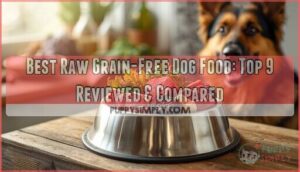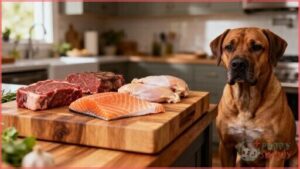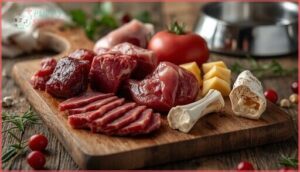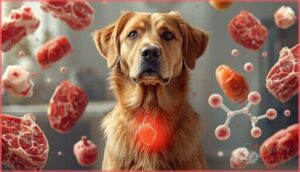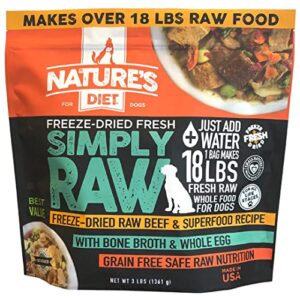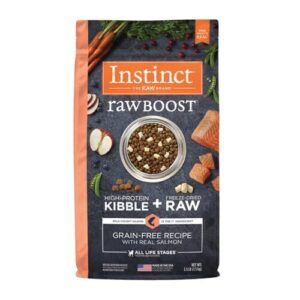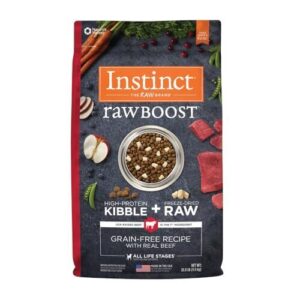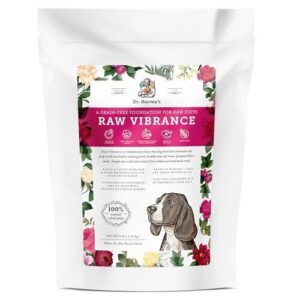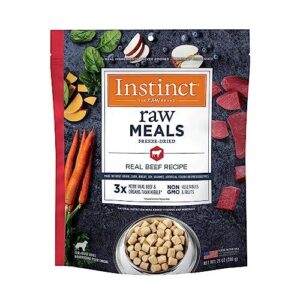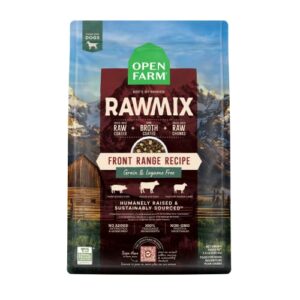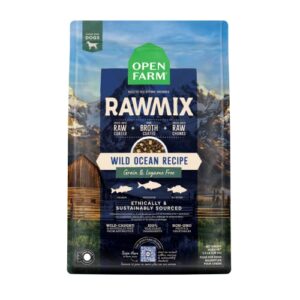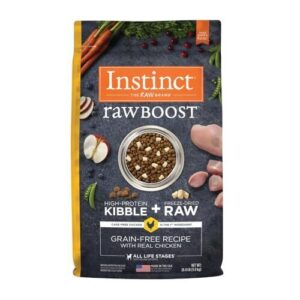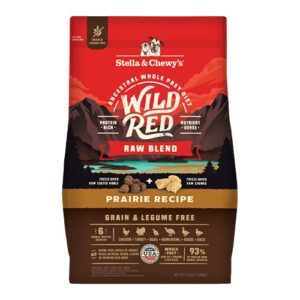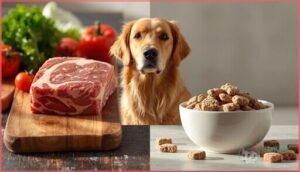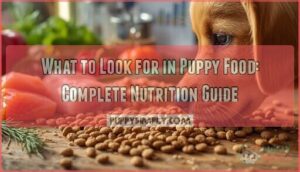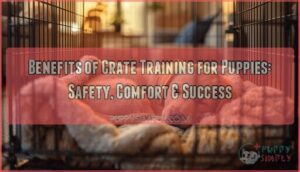This site is supported by our readers. We may earn a commission, at no cost to you, if you purchase through links.
Your dog’s gut is home to trillions of bacteria, and what you feed them directly shapes whether those microbes help or harm their health. Raw grain-free dog food has gained attention for supporting digestive balance, reducing inflammatory responses, and delivering nutrients in their most bioavailable forms.
Unlike heavily processed kibble, raw diets preserve natural enzymes and provide protein from whole meat sources rather than rendered meals or plant-based fillers.
If you’re considering this approach, you’ll need to evaluate ingredient quality, nutritional completeness, and safety protocols. The nine products reviewed here represent options backed by nutritional research, from frozen raw blends to freeze-dried formulas that balance convenience with the benefits of uncooked feeding.
Table Of Contents
- Key Takeaways
- Benefits of Raw Grain-Free Dog Food
- Key Ingredients in Raw Grain-Free Diets
- Top 9 Raw Grain-Free Dog Foods
- 1. Nature’s Diet Raw Beef Dog Food
- 2. Instinct Raw Boost Salmon Dog Food
- 3. Instinct Raw Boost Real Beef Recipe
- 4. Dr. Harvey’s Raw Vibrance Dog Food
- 5. Instinct Freeze Dried Raw Beef Dog
- 6. Open Farm RawMix Beef Dog Food
- 7. Open Farm Salmon Whitefish Dog Food
- 8. Instinct Raw Boost Chicken Dog Food
- 9. Stella Chewy’s Wild Red Raw Blend
- Comparing Raw and Grain-Free Kibble Diets
- Safely Transitioning to Raw Grain-Free Food
- Frequently Asked Questions (FAQs)
- Why do vets not recommend grain-free dog food?
- Why don t vets like raw dog food?
- Does raw food contain grains?
- How much does grain-free dog food cost?
- How do I prepare raw food for my dog?
- Are there any health risks associated with grain-free diets?
- What are some alternatives to grain-free dog food?
- How do I know if my dog has food allergies or sensitivities?
- How much does raw grain-free food cost?
- Do senior dogs benefit from raw diets?
- Conclusion
Key Takeaways
- Raw grain-free dog food improves digestion by increasing protein digestibility up to 60% compared to grain-inclusive diets, resulting in firmer stools, better nutrient absorption, and resolution of chronic digestive issues within 1-2 weeks.
- The FDA has linked grain-free diets to dilated cardiomyopathy (DCM) in dogs, with over 90% of reported cases involving grain-free formulas, particularly those heavy in legumes that may interfere with taurine production necessary for heart health.
- Quality raw grain-free diets should contain 70-80% muscle meat, 10-15% bone, and 10% organ meats to provide complete nutrition, while avoiding legume-heavy formulas that substitute grains with peas and lentils.
- Transitioning to raw grain-free food requires a gradual 12-day process starting with 25% raw mixed with 75% old food, plus strict safety protocols including refrigeration at 40°F or below and discarding uneaten portions after 2 hours due to Salmonella and Listeria contamination risks.
Benefits of Raw Grain-Free Dog Food
When you switch your dog to a raw grain-free diet, you’re likely to notice some real changes pretty quickly. Better digestion, healthier skin, and a stronger immune system aren’t just marketing promises—they’re backed by what pet owners and research are actually seeing.
Let’s walk through the main benefits that make raw feeding worth considering for your dog.
Improved Digestion and Stool Quality
Better digestion starts with what’s in your dog’s bowl. Raw grain-free dog food enhances enzyme activity, allowing your dog’s system to absorb nutrients more efficiently—you’ll notice the difference in stool firmness and reduced output within weeks.
Here’s what improves:
- Protein digestibility increases up to 60% compared to grain-inclusive diets
- Stool becomes noticeably firmer and more compact
- Gut microbiome diversity expands with beneficial bacteria
- Food intake needs drop 13% while maintaining body condition
- Digestive disorders like chronic diarrhea generally resolve within 1-2 weeks
Your dog’s digestion is the foundation for everything else—energy, immunity, and long-term health. A balanced diet can greatly impact the pet’s gut health.
Reduced Allergies and Healthier Skin
Food allergies affect up to half of dogs with allergic skin disease, yet the right diet can turn things around. Raw grain-free diets work by eliminating common triggers like wheat and corn while providing meat-based proteins your dog’s system recognizes easily. Clinical studies show dogs on elimination diets improve 18–69% of the time.
For dogs with sensitivities, grain-free dog foods can alleviate skin allergies and digestive issues. Omega-3 fatty acids from fish and flax further calm inflammation, reducing itching and restoring coat quality within weeks.
| Skin Concern | Raw Grain-Free Support |
|---|---|
| Itching & Redness | High-quality meat proteins eliminate trigger ingredients |
| Bacterial Infections | Improved skin barrier from omega-3s reduces 11–70% infection risk |
| Ear Inflammation | Reduced allergens address otitis in 3–69% of cases |
Enhanced Immune System and Oral Health
Beyond skin health, raw grain-free diets strengthen your dog’s defenses from the inside out. Dogs on raw diets show markedly elevated fecal IgA and IgG levels, reflecting enhanced gut immunity. Their clinical health scores consistently outperform kibble-fed counterparts, with lower inflammatory markers and improved gut microbiota diversity.
Meaty bones naturally reduce dental calculus formation, supporting cleaner teeth and healthier gums—benefits that translate into fewer oral infections and stronger overall resilience.
Suitability for Dogs With Grain Sensitivities
True grain allergies affect less than 1% of dogs—yet half of pet owners believe grain-free diets are healthier. If your dog shows genuine grain sensitivity, raw dog food offers relief without legume-heavy grain alternatives found in kibble.
Certain breeds like Border Terriers face higher breed predisposition to gluten issues.
Proper allergy diagnosis through elimination diets confirms whether grain-free raw diets for dogs with sensitive stomachs deliver real diet efficacy or simply align with owner perceptions.
Key Ingredients in Raw Grain-Free Diets
Not all grain-free dog foods are created equal, and the difference comes down to what’s actually in the bowl. Raw grain-free diets rely on nutrient-dense whole foods that mirror what dogs would eat in nature, not fillers or substitutes.
Let’s break down the essential components that make a raw grain-free diet truly complete.
High-quality Meat-based Protein Sources
When choosing raw dog food, muscle meat should anchor the formula. Your dog’s body thrives on animal protein that delivers amino acid profiles perfectly matched to canine needs.
High-quality protein from sources like beef, chicken, and salmon offers protein digestibility rates exceeding 90%, far surpassing plant alternatives. This outstanding bioavailability means your dog absorbs more of what matters for muscle maintenance and energy.
Role of Organ Meats, Bones, and Fat
After muscle meat comes the nutritional powerhouse trio: organ meats, raw bones, and dietary fat. Organ meat should comprise 10–15% of your raw dog food to deliver fat-soluble vitamins A, D, E, and K without risking toxicity.
Raw bones supply bioavailable calcium at ideal ratios, while measured fat intake—avoiding excessive levels—aids vitamin absorption and energy without triggering obesity risks.
Importance of Taurine and Essential Amino Acids
While dogs synthesize Taurine internally, certain breeds and grain-free diets rich in legumes can impair this process, triggering DCM link concerns.
Your raw dog food should prioritize high-quality protein sources like fresh muscle meat and organs, which deliver enhanced amino bioavailability compared to plant proteins.
Adequate methionine and cysteine—essential amino acids—guarantee your dog produces enough Taurine naturally, making raw formulation choices critical for long-term heart health.
Inclusion of Fresh Produce and Value-added Nutrients
Beyond meat alone, your raw dog food gains tremendous nutritional value from fresh produce and fortified ingredients. Vegetables like kale and carrots supply fiber for digestion, while berries deliver phytonutrient benefits that support gut microbiota diversity.
Commercial grain-free formulas often include chelated minerals for enhanced bioavailability, plus vitamin enrichment through added E and C—ensuring complete dog food nutrition that kibble rarely matches.
Top 9 Raw Grain-Free Dog Foods
Now that you understand what makes a quality raw grain-free diet, you’re ready to see which products actually deliver.
The following nine options stand out for their high meat content, minimal fillers, and balanced nutrient profiles. Each brings something different to the table, so you can find the right fit for your dog’s specific needs.
1. Nature’s Diet Raw Beef Dog Food
When you’re searching for a raw dog food that checks every box, Nature’s Diet Raw Beef stands out for its beef recipe analysis and nutritional completeness. You’ll find 96% muscle, organ, and bone in the Ready Raw formula, delivering enhanced digestibility benefits with amino acid absorption exceeding 90%.
The ingredient sourcing follows human-grade standards, and safety standards include High Pressure Pasteurization to eliminate pathogens.
This grain-free dog food provides omega fatty acids, probiotics, and AAFCO-compliant vitamins, making it a complete raw diet that promotes your dog’s health from the inside out.
Best For: Dog owners who want a nutrient-dense, minimally processed raw diet with human-grade beef and organs, especially for pups with food sensitivities or digestive issues.
- High protein content with 96% meat, organ, and bone in Ready Raw formula, plus exceptional amino acid digestibility over 90%
- Human-grade ingredients processed with High Pressure Pasteurization for safety, plus added probiotics and omega fatty acids for gut and coat health
- Grain-free and free from common allergens, artificial additives, and fillers, making it suitable for dogs with sensitivities
- Strong smell that some dogs and owners find off-putting, leading to refusal to eat in some cases
- Inconsistent texture issues reported when rehydrating, with some batches having excessive powder or not congealing properly
- Customer service responsiveness has been a concern for owners trying to resolve product issues
2. Instinct Raw Boost Salmon Dog Food
If you’re looking for a kibble-raw hybrid, Instinct Raw Boost Salmon Dog Food delivers 31.5% protein with wild-caught salmon as its primary protein source. This grain-free dog food combines crunchy kibble with freeze-dried raw pieces, offering raw boost benefits like higher omegas and 80 million CFU probiotics per pound.
It meets AAFCO compliance for all life stages except large-breed puppies. While the formula includes taurine at 0.1%, some ingredient concerns exist around legumes.
The brand’s recall history includes 2015 Salmonella incidents in frozen raw lines, though no recent issues affect this dry formula.
Best For: Dog owners seeking a high-protein, grain-free diet with the convenience of kibble plus freeze-dried raw nutrition for all life stages (excluding large-breed puppies over 70 lb).
- Wild-caught salmon as the first ingredient delivers 31.5% protein to support lean muscle, plus 80 million CFU probiotics per pound for digestive health
- Combines crunchy kibble with freeze-dried raw pieces for higher omegas (1.1% omega-3, 2.0% omega-6) and antioxidants compared to standard formulas
- No grain, corn, wheat, soy, by-product meals, or artificial preservatives, with added taurine (0.1%) to address grain-free diet concerns
- Not suitable for large-breed puppies expected to exceed 70 lb as adults, despite “all life stages” claim
- Legume-heavy carbohydrate sources (peas, chickpeas) and questionable fillers like tomato pomace raise ingredient quality concerns
- Historical Salmonella recalls in 2015 frozen raw lines and isolated reports of inconsistent quality or contamination in packages
3. Instinct Raw Boost Real Beef Recipe
Instinct Raw Boost Real Beef Recipe switches from salmon to USA-raised beef as its first ingredient, delivering above-average protein and fat with below-average carbs in a grain-free dog food format. You’ll find freeze-dried raw beef pieces coating the kibble, plus guaranteed live probiotics for digestive support.
The caloric density sits around 360–485 kcal per cup, so portion control matters. This raw diet hybrid meets AAFCO standards for all life stages except large-breed puppies over 70 lb.
Of particular interest, the beef recipe contains chicken meal—check labels if your dog has protein sensitivities.
Best For: Dogs with food sensitivities who need a high-protein, grain-free diet with raw nutrition—just watch out if your pup has chicken allergies since this beef recipe includes chicken meal.
- USA-raised beef as the first ingredient plus freeze-dried raw pieces deliver above-average protein (great for muscle maintenance) and higher omegas for skin and coat health
- Live probiotics and antioxidant-rich fruits support digestive health and immune function in one complete formula
- No recalls reported through 2025, and it meets AAFCO standards for puppies, adults, and small/medium seniors
- Contains chicken meal despite the “beef” branding, which can trigger reactions in dogs with poultry sensitivities
- High caloric density (360–485 kcal per cup) requires careful portion control to avoid weight gain
- Some quality control complaints on Amazon, including reports of bugs in packages and inconsistent batches
4. Dr. Harvey’s Raw Vibrance Dog Food
Dr. Harvey’s Raw Vibrance shifts the conversation from ready-to-feed formats to a dehydrated base mix you customize. This grain-free dog food combines 24 human-grade whole foods—vegetables, bone meal, green-lipped mussels, shiitake mushrooms—that you rehydrate for eight minutes, then add your choice of raw protein and oil.
The ingredient quality stands out: non-GMO produce, no fillers or preservatives. Customer reviews consistently report firmer stools and shinier coats.
At 11% crude protein in the mix alone, nutritional completeness depends entirely on following feeding guidelines for meat and fat additions.
Best For: Dog owners who want full control over their pet’s diet and don’t mind the extra prep work of adding fresh protein and oil to a dehydrated base mix.
- Human-grade, non-GMO ingredients with functional superfoods like green-lipped mussels and shiitake mushrooms for joint and immune support
- Lets you rotate different proteins and customize fat content based on your dog’s specific needs or sensitivities
- Users consistently report better digestion, firmer stools, and noticeably shinier coats
- Requires more effort than standard kibble—you need to rehydrate, add meat, and measure oil for every meal
- Higher upfront cost, and you’re still buying protein separately to make it nutritionally complete
- Some picky eaters need coaxing, and the powder can settle into sediment at the bottom of the bag
5. Instinct Freeze Dried Raw Beef Dog
While Dr. Harvey’s lets you customize protein, Instinct Freeze Dried Raw Beef Dog Food delivers complete nutrition straight from the bag. The freeze-dried process locks in 36–38% crude protein and 29–34% fat without cooking, preserving bioavailability that heat destroys.
You’re feeding 85–88% animal ingredients—beef muscle, liver, kidney, heart—plus non-GMO vegetables and supplemented taurine.
Customer reviews average 4.2 stars, with owners noting firmer stools and vibrant coats. Feed 1–4.5 cups daily depending on your dog’s weight, or rehydrate with two tablespoons of water per cup.
Best For: Dog owners who want to feed a minimally processed, nutrient-dense raw diet without the hassle of meal prep or refrigeration.
- Contains 85–88% real animal ingredients including beef muscle and organs, delivering 36–38% protein that’s preserved through freeze-drying instead of heat processing
- Supports healthy digestion and coat quality with complete nutrition straight from the bag—just scoop and serve, or rehydrate if preferred
- Versatile feeding options work as a complete meal, topper, or training treat for dogs at any life stage
- Significantly more expensive than traditional kibble, with a 25-ounce bag often not lasting long for larger dogs
- Freeze-dried pieces can be fragile and crumble easily, making them messy for travel or on-the-go training
- High caloric density (up to 4,754 kcal/kg) requires careful portion control to avoid overfeeding and weight gain
6. Open Farm RawMix Beef Dog Food
Open Farm RawMix Beef Dog Food blends kibble with freeze-dried raw chunks for sourcing transparency you can verify—100% animal welfare certified grass-fed beef, pasture-raised lamb, and pork. You’re feeding 30% protein and 15% fat with no grains or legumes.
The RawMix benefits include added taurine (0.2% minimum) and 0.40% omega-3s, though ingredient analysis reveals 33% carbohydrates.
Consumer feedback averages positive for palatability, yet some owners report digestive variability. Feed this nutritional profile knowing every ingredient is traceable and third-party tested.
Best For: Dog owners who want traceable, ethically sourced ingredients and are willing to pay premium prices for a grain-free formula with freeze-dried raw chunks, especially if their dog has food sensitivities.
- 100% animal welfare certified proteins (grass-fed beef, pasture-raised lamb and pork) with full traceability and no antibiotics or hormones
- High protein content (30%) with added taurine, omega-3s, and freeze-dried raw pieces for enhanced nutrition and palatability
- Grain-free and legume-free formula with no recalls, rigorous testing, and transparent sourcing practices
- Higher price point than most dog foods on the market
- Some dogs experience digestive issues despite the quality ingredients, with variable results reported
- Contains 33% carbohydrates and smaller kibble size may pose choking risks for larger dogs
7. Open Farm Salmon Whitefish Dog Food
You’re choosing wild-caught salmon and ocean whitefish for protein quality that delivers 30% crude protein and 0.4% omega-3s—omega balance your dog’s skin and joints need. Open Farm’s ingredient sourcing traces every marine protein to certified fisheries, though the RawMix contains legumes that some dogs struggle with for digestibility factors.
Consumer reports flag palatability issues and occasional loose stools, yet many owners praise the freeze-dried raw chunks. This grain-free dog food offers transparency, but watch your pup’s response during the first week of raw dog food feeding.
Best For: Dog owners looking for traceable, wild-caught fish protein with transparent sourcing, especially if their dog has poultry or grain sensitivities.
- High protein at 30% with omega-3s from salmon and whitefish supporting skin, coat, and joint health
- Certified humane and responsibly sourced marine ingredients with full traceability
- Includes freeze-dried raw chunks and supplemental taurine (0.1-0.2%) for heart health
- Legume-based carbohydrates (chickpeas, lentils) may cause digestive upset in sensitive dogs
- Higher price point compared to conventional kibbles with mixed customer reports on palatability
- Some batches contain less freeze-dried raw content than expected, and kibble size may pose choking risk for larger breeds
8. Instinct Raw Boost Chicken Dog Food
With cage-free chicken leading a 39% protein formula, this raw dog food delivers the nutritional profile your dog’s muscles and immune system thrive on. Instinct Raw Boost Benefits include freeze-dried raw pieces coating grain-free kibble, plus probiotics that tighten stool quality—clinical data backs firmer consistency in raw diet transitions.
Ingredient Analysis reveals salmon oil for omegas and organ meats for amino acids, though Consumer Reviews note quality control lapses from Amazon shipments.
Safety Concerns remain minimal with no recalls, yet you’ll pay premium prices for this grain-free dog food option.
Best For: Dog owners wanting a high-protein, grain-free diet with raw nutrition who don’t mind paying premium prices and have dogs without severe food allergies.
- 39% protein from cage-free chicken and organ meats supports strong muscles and immune health
- Freeze-dried raw coating plus probiotics improve digestion and stool quality
- No recalls, grain-free formula, and rich in omega fatty acids for healthy skin and coat
- Premium pricing (typically over $80 per bag) makes it more expensive than standard kibble
- Quality control issues reported by some Amazon customers, including contamination complaints
- Not suitable for large breed puppies or dogs with sensitivities to ingredients like salmon oil or tomato pomace
9. Stella Chewy’s Wild Red Raw Blend
With six premium poultry sources delivering 36% protein, this raw-coated kibble combines freeze-dried raw chunks with grain-free pellets—90% of its protein comes from animal sources, not legumes. The Wild Red Raw Blend offers grain-free benefits through sweet potato and tapioca instead of problematic peas, plus added taurine for cardiac support.
Customer reviews praise ingredient quality and probiotics for digestive health, though some note limited raw content justifies the premium price. You’re feeding a raw diet format without full refrigeration demands.
Best For: Dog owners who want the nutritional benefits of raw feeding without full refrigeration, especially those avoiding grains and legumes while prioritizing high animal-protein content.
- 36% protein with 90% from six premium poultry sources, plus freeze-dried raw chunks mixed into every bag for authentic raw nutrition
- Grain-free and legume-free formula uses sweet potato and tapioca instead of peas or lentils, with added taurine for heart health
- Probiotics and whole-prey ingredients (organs, cartilage, tripe) support digestion and provide naturally occurring vitamins and minerals
- Premium price point may not justify the actual amount of freeze-dried raw content some customers found in their bags
- Some dogs experienced digestive issues or simply didn’t like the taste, despite the quality ingredients
- Inclusion of chicken meal and turkey meal disappointed customers expecting only whole meat proteins
Comparing Raw and Grain-Free Kibble Diets
Not all grain-free diets are created equal, and the differences between raw and kibble formulas can greatly impact your dog’s health. Raw diets generally offer better protein quality and lower carbohydrate loads, while grain-free kibble often relies on plant-based substitutes that don’t measure up nutritionally.
Let’s examine how these feeding approaches compare across protein sources, carbohydrate content, clinical outcomes, and recent safety considerations.
Protein Quality: Meat Vs. Plant-based
Your dog needs all 10 essential amino acids to thrive, and animal protein delivers them naturally. Meat, poultry, and fish offer complete amino acid profiles with enhanced protein digestibility and biological value compared to most plant sources.
While legumes like peas and lentils appear in many grain-free kibbles, they can’t match the taurine sources found in raw dog food—heart and liver pack concentrated levels your dog’s body recognizes and uses efficiently.
Carbohydrate Content and Substitutes
Raw dog food generally contains less than 5% carbohydrates—some formulas approach zero—while grain-free kibble still packs 20%–50% due to carb substitutes like potatoes, legumes, peas, and lentils.
These alternatives provide fiber content and structure but dramatically increase sugar levels compared to raw diets.
That metabolic impact matters: low-carb raw feeding improves your dog’s blood glucose control and insulin sensitivity.
Health Outcomes and Clinical Findings
Clinical evidence paints a compelling picture: your dog’s health markers shift measurably when you switch feeding strategies.
Here’s what peer-reviewed studies document:
- Stool consistency improved markedly in raw-fed dogs (P Taurine deficiency causes DCM regardless of diet format—it strikes whenever recipes lack sufficient muscle and organ meats
Raw diets aren’t automatically safer. Tufts cardiologists diagnosed DCM in dogs eating raw and home-prepared meals lacking formal nutrient testing. The key difference? Balanced raw formulas built around 80% meat, organ, and bone naturally deliver bioavailable taurine and its precursors without relying on pulses or potatoes as protein fillers.
The FDA stopped routine updates in February 2023, calling the diet-DCM relationship “complex” with no single culprit identified. Current guidance emphasizes individualized risk assessment rather than blanket warnings. For your dog’s protection, prioritize raw food recipes from manufacturers employing veterinary nutritionists, avoid boutique formulas heavy in peas or lentils, and consider whole-blood taurine testing for at-risk breeds like golden retrievers and Dobermans.
Safely Transitioning to Raw Grain-Free Food
Switching your dog to a raw grain-free diet isn’t something you should rush. A careful, gradual approach protects your dog’s digestive system and sets the stage for long-term success.
Here’s how to make the switch smooth, safe, and stress-free for both you and your dog.
Step-by-step Transition Guide
When switching your dog to a raw grain-free dog food, start with a 12–24 hour fasting duration for adults—puppies skip this step.
Begin by blending 25% raw diet with 75% old food for three days, gradually increasing the raw portion every few days. Stool monitoring guides your adjustment speed.
Introduction of red meats should be delayed until digestion stabilizes around day ten.
Preventing Digestive Upset
Digestive health depends on thoughtful ingredient selection and understanding your dog’s unique microbiota health. Dogs with sensitive stomachs need extended adjustment periods—sometimes 14 days or more—to adapt their gut flora.
Monitoring practices like tracking stool quality daily help you catch issues early. Choose raw dog food with minimal fermentable fibers to reduce gas and bloating.
If symptoms persist beyond two weeks, contact your vet immediately.
Ensuring a Balanced and Complete Diet
Once your dog’s stomach settles, you’ll need to verify your raw dog food delivers complete nutritional balance. AAFCO guidelines require precise nutrient ratios—70-80% muscle meat, 10-15% bone, 10% organ meats. Supplementation needs include taurine, calcium, and omega-3s to prevent deficiencies.
Monitoring strategies like quarterly blood work catch imbalances early, while ingredient diversity across protein sources strengthens risk mitigation against micronutrient gaps in grain-free dog food.
Proper Storage and Handling of Raw Food
Since raw dog food safety depends on strict protocols, you’ll need to master cold storage and pathogen control. Cross-contamination threats from Salmonella and Listeria demand vigilance at every step.
Follow these raw food storage essentials:
- Keep frozen at 0°F until thawing practices begin in the refrigerator—never at room temperature
- Use thawed portions within 4-5 days under refrigeration at 40°F or below
- Discard uneaten food after 2 hours at room temperature
- Wash hands and surfaces before and after handling to prevent cross-contamination
- Store in sealed containers separate from human food to minimize pathogen risks
Frequently Asked Questions (FAQs)
Why do vets not recommend grain-free dog food?
Many vets hesitate to recommend grain-free diets because of a potential DCM link. Studies show over 90% of reported cases involved grain-free dog food, raising concerns about taurine deficiency and nutritional balance despite an ongoing FDA investigation.
Why don t vets like raw dog food?
Vets formally discourage raw dog food because FDA testing found Salmonella in 7% and Listeria in 3% of samples—levels far exceeding traditional kibble—posing real infection risks to both you and your pet.
Does raw food contain grains?
Most raw dog food is naturally grain-free, containing zero corn, wheat, rice, or barley.
Over 90% of commercial raw diets focus on meat, organs, and bone—leaving no room for grain-derived ingredients.
How much does grain-free dog food cost?
Grain-free dog food costs vary widely: raw options run $2–$9 daily ($60–$270 monthly), while kibble ranges $30–$90 per bag. Subscription services like The Farmer’s Dog charge $49–$42 daily, depending on your dog’s size.
How do I prepare raw food for my dog?
Start with veterinary-formulated recipes to guarantee proper nutrient balancing and supplement usage.
Follow strict hygiene practices during food preparation, use safe freezing methods and raw food defrosting techniques, and maintain veterinary oversight throughout your dog’s adjustment.
Are there any health risks associated with grain-free diets?
Yes—the FDA linked grain-free diets to DCM in dogs, particularly foods with legumes. Over 90% of reported DCM cases involved grain-free dog food, raising concerns about taurine deficiency, nutrient imbalance, and dog health risks.
What are some alternatives to grain-free dog food?
You can choose grain-inclusive options with whole grains like rice or oats, fresh-cooked diets, limited ingredient formulas, cold-pressed alternatives, or veterinary diets—each addressing specific needs beyond standard grain-free dog food approaches.
How do I know if my dog has food allergies or sensitivities?
Watch for persistent itching, red skin, ear infections, or digestive issues like diarrhea.
An elimination trial with hypoallergenic dog food for allergies remains the best approach for diagnosing true sensitivities versus environmental triggers.
How much does raw grain-free food cost?
Raw grain-free dog food generally costs $50 to $150 monthly, depending on your dog’s size and brand selection. Daily feeding costs range from $2 to $9, roughly double what grain-free kibble requires.
Do senior dogs benefit from raw diets?
Senior dogs thrive on raw food diets through excellent muscle maintenance, enhanced digestive efficiency, improved allergy outcomes, immune support, and joint health—all critical for aging pet health.
These benefits are particularly important for grain-free dog nutrition, as their bodies demand higher-quality protein.
Conclusion
Your dog’s health hinges on what you feed them today. Choosing raw diet grain-free dog food isn’t just about avoiding grains—it’s about providing species-appropriate nutrition that aids digestion, reduces inflammation, and delivers nutrients in their most usable form.
The nine products reviewed here offer proven options, but your dog’s individual needs matter most. Start with careful transitions, prioritize complete formulations, and monitor your pet’s response. Their vitality depends on decisions you make now.
- https://pmc.ncbi.nlm.nih.gov/articles/PMC12560912/
- https://www.vvs.vet/raw-diets/
- https://www.advancedanimalcare.shop/post/kibble-vs-raw-dog-food-what-does-the-latest-research-say
- https://www.fda.gov/animal-veterinary/outbreaks-and-advisories/fda-investigation-potential-link-between-certain-diets-and-canine-dilated-cardiomyopathy
- https://www.prodograw.com/nutrition/latest-raw-dog-food-research-and-studies/

